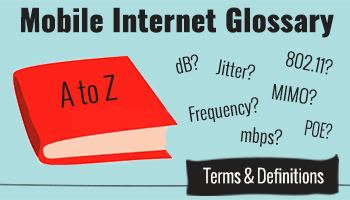
Before you get frustrated wondering why you might need a POE to power your CPE to get remote 802.11g when you’d really rather have more dB on your LTE – check our glossary below.
-
5G
"5G represents the fifth generation of cellular technology, and is the successor to 4G/LTE.
5G takes advantage of many chunks of spectrum ranging from long-range UHF frequencies up through short-range extremely high millimeter-wave frequencies (mm Wave)
When broadcast over long-range frequencies, 5G may only have a modest speed improvement over 4G/LTE. In core urban and suburban areas that are frequently overloaded in the 4G/LTE spectrum the extra capacity that 5G brings to cellular allows for dramatic overall improvements.
NOTE: 5G cellular and 5Ghz Wi-Fi are entirely different things."
-
802.11
"The IEEE 802.11 set of technical standard is the formal name for the wireless technology commonly referred to as Wi-Fi.
The 802.11 standard comes in an alphabet soup of flavors, which are appended to the end (e.g. 802.11ax). 802.11 has become more commonly referred to as simply 'Wi-Fi' and then a generation number (such as 'Wi-Fi 5')."
-
AirCard
The former brand name for cellular mobile hotspot devices from Netgear (formerly Sierra Wireless). They are often incorrectly referred to as Jetpacks or MiFis, which are actually trademarked brands for hotspots by Verizon and Inseego.
-
Amplifier
Increases the strength of an available wireless signal. The amplifier is the electronic part of a cellular booster kit that is providing the power.
-
AMPS
Stands for Advanced Mobile Phone System, the original first generation (1G) analog cellular network widely deployed in the 1980s and 1990s.
The AMPS network was phased out in the USA in 2008.
-
Analog
Analog radio signals are made up of waves that have not been digitized – meaning that anyone with a compatible tuner can listen in. Analog radio is easy to eavesdrop upon, is a very inefficient use of spectrum, and it suffers from static and other interference – especially as distance increases.
The analog AMPS cellular network was at last fully shut down in 2008, but other wireless analog communication technologies remain – such as CB and ham radio.
-
Android
Google’s smartphone operating system.
-
Antenna
An antenna takes electrical input and broadcasts it out as radio waves, or receives radio waves and provides an electrical signal to a device to utilize that signal.
An antenna needs to be designed and carefully tuned for the frequencies that it needs to support, and they come in a variety of specifications for gain.
In terms of mobile internet, antennas are used for cellular, Wi-Fi, and satellite devices. They can be built directly in devices, or be externally attached via ports.
-
AOL
Refers to 'Assumption of Liability'. This process can sometimes be used to assume the liability of an account. This may also be referred to as a transfer of service.
Can also refer to 'America Online' - an early dial-up internet service provider.
-
APN
The APN (Access Point Name) acts as a gateway between your cellular device and the carrier's data network. Every cellular device needs an APN and that APN must be one compatible with the cellular carrier, device, and SIM being used.
-
AT&T
One of America's major cellular carriers, often referred to as the Blue Carrier. They also own the prepaid cellular brand Cricket Wireless.
For more: Which Cellular Carrier is Best for RV or Boat Mobile Internet?
-
Attenuation
Attenuation is the measurement of signal loss over a distance in a wire or through the air, usually reported as decibels per unit length (dB/cm or dB/ft). This measurement is important for antenna cables – "low- loss" cables have much less attenuation over a given distance.
-
Band
The radio spectrum is divided up into sections (bands) defined by signal frequency. Each section is known as a band.
Standardized bands of LTE or 5G frequencies are set aside for cellular service, and of note: each carrier utilizes different bands. When shopping for gear, it's important to select gear that supports at a minimum the core bands your carrier uses.
-
Bandwidth
Bandwidth is the size of a wireless frequency channel (band). Think of it like how many lanes there are on a highway, or the size of a water hose.
The larger the bandwidth allotted to a channel, the more information that channel can carry.
The available bandwidth is what limits capacity on a wireless network - whether it's cellular or Wi-Fi. It's why when there are a lot of people sharing that same wireless signal, speeds become slower than when there's less congestion.
-
Bandwidth Cap
Also know as a data cap, this is an imposed limit on the amount of data that can be used over a certain period of time. It may also be specific to a feature, such as mobile hotspot use or roaming. Once you exceed that cap, speeds are generally reduced - or on some tiered data plans, data is cut off.
-
Bars
On mobile devices, bars are an approximate visual representation of cellular signal strength.
Each device calculates them differently. The number of bars a device is displaying doesn't always have a direct correlation to how fast an internet connection will be - there are far too many variables.
So we suggest instead running speed tests to check the quality of your internet connection and leaving bars to drown your sorrows when you can’t get online any other way. As an alternative, consider keeping a box of wine handy.
-
Bluetooth
Bluetooth is a slow, short range wireless communication technology most commonly used for wireless headsets and speakers. Though Bluetooth uses the same 2.4GHz frequencies as Wi-Fi, it is designed to avoid interference – and usually succeeds.
-
Bonding
Also called "channel bonding," this is an advanced technique that lets a router combine multiple internet connections together into a virtual single connection for faster performance. So, for example, a router that supports bonding could combine two 4G hotspot connections into a faster, single connection.
This feature, when it is supported in router hardware, is generally found on high-end gear, and usually requires a dedicated server to combine the traffic together (often resulting in an expensive subscription service fee). The server and subscription costs plus the technical complexity tend to relegate this option to users with extreme geek skills or highly specialized needs.
Bonding can also be accomplished with software and a VPN on a per-device basis. For example, Speedify software and service allows users to bond multiple USB tethered devices (and even Wi-Fi) together on a PC.
-
Boost Mobile
Boost Mobile started out as as a prepaid brand, but is now the brand name used by Dish Wireless. They offer both prepaid and postpaid plans.
-
Booster
Boosters are amplifiers used to improve wireless signal reception. Most common are cellular boosters to help smartphones and mobile hotspot devices receive a stronger cellular signal.
However because of a core cellular technology called MIMO, boosters do not always translate to better mobile internet speeds. But they can still make a difference in some situations.
-
bps
Stands for bits per second. The smallest unit of computing is a bit – 0 or 1. Network speeds are measured in how many of these bits are capable of being sent per second. It takes 8 bits to make a “byte,” and one byte usually represents a single character of text.
-
Broadband
In radio communications, broadband refers to a high capacity transmission using a wide range of frequencies. This capacity means its capable of transporting multiple signals simultaneously.
Broadband is a relative term – and over time what it takes to be considered “broadband” has been gradually increasing.
-
BYOD
BYOD stands for 'bring your own device', and most often refers to a carrier or vendor's stance on whether or not you must purchase a device through them, or can provide your own.
-
Calyx Institute
The Calyx Institute is a non-profit organization who offers memberships that include unlimited data plans on T-Mobile's network using a provided hotspot device.
-
Carrier Aggregation
Carrier aggregation is a core cellular technology that combines multiple channels from different chunks of spectrum to make a higher bandwidth virtual channel that can support faster speeds.
Most modern 4G/LTE and 5G cellular modems have embraced this technology, and support for carrier aggregation is absolutely critical to achieving peak cellular performance.
Older LTE Cat-3 and most Cat-4 modems however are limited to connecting to just one single channel at a time.
-
CBRS
The Citizens Broadband Radio Service (CBRS) is a chunk of 3.5GHz spectrum that the FCC has set aside for future use for 4G/LTE cellular, 5G, and other innovative uses. When used for LTE, CBRS is defined as LTE Band 48.
CBRS is pioneering an innovative approach to sharing access to spectrum - with military radar and existing satellite operations grandfathered in while in use, then there is a second tier of Priority Access Licenses (PAL) that are being auctioned off to telecommunications companies for 5G and expanded LTE service.
Finally, there is a third tier of access that is open to anyone without a license - similar to Wi-Fi. Devices operating at this level will have to be a good neighbor with other nearby devices.
-
CDMA
Code Division Multiple Access (CDMA) is the common name for the IS-95 and CDMA2000 standards for 2G and 3G cellular networks originally embraced by Verizon and Sprint in the USA.
4G/LTE and 5G cellular generation technologies have pretty much replaced 2G and 3G technologies. 3G service has been ended in the US.
-
Cellular
Cellular represents a wireless technology that allows smartphones to make calls, receive texts or browse the web. A smartphone, tablet, hotspot device or cellular router can convert cellular signal into Wi-Fi or ethernet to get laptops and other devices online - providing the data plan allows for the hotspot feature.
Cellular carriers (Verizon, AT&T, T-Mobile or Sprint) deploy equipment where they have customers to transmit a long range wireless signal, ranging from a mile to dozens of miles. They design their footprint so that there is overlap in their signal, creating 'cells' that make up their coverage map.
-
Cellular Adapter
These devices contain a cellular modem, but do not have their own router LAN functionality. They must be plugged directly into either a computer or router to use the internet connection. They come in variations that connect via USB and Ethernet. Examples include the Peplink MAX Adapter (USB) or InvisaGig (Ethernet).
-
Channel
A channel represents the frequency a signal is being broadcast upon and the bandwidth that it occupies.
As an analogy, the frequency is the address of the channel, and the bandwidth is the size of the house.
The more bandwidth a given channel takes up, the fewer of them you can have in a given slice of spectrum.
-
Cloud SIM
Cloud SIM technology allows users to choose the best network coverage among all available networks and initiate service on it. A cloud SIM provider may allow a user to choose their network manually, may automatically select a network for the user based on the location the service is being requested, or have a user contact the provider to change the service.
-
CPE
CPE stands for “customer premises equipment” and is the term used for commercial-grade Wi-Fi access points used to provide Wi-Fi in a campground or marina. The equipment combines an antenna and radio into one device to minimize signal loss.
Consumers can also use CPE equipment to maximize their own Wi-Fi receive range, and many available Wi-Fi extending options are actually CPEs.
-
Decibel
Decibel(dB) is the unit of measure for the power of an electrical signal or the intensity of a sound. The logarithmic decibel scale is used to indicate the amount of gain an amplifier or antenna provides, or the loss introduced over wires. Positive numbers represent amplification, and negative numbers represent loss.
On the decibel scale, every 3dB represents a 2x increase, and every −3dB decrease represents 1/2. 10dB represents a 10x increase, 20dB represents 100x, 30dB represents 1000x, and so on.
-
DHCP
DHCP (Dynamic Host Configuration Protocol) is the magic that happens behind the scenes that allows your computer and other devices to automatically configure to connect to the upstream router. The router uses DHCP to assign each device an IP address and tells it what DNS service to use. If your computer and the DHCP server get out of sync, learning how to tell your computer to “Renew DHCP Lease” might be what it takes to fix things. (Rebooting accomplishes the same thing too.)
-
Dial-Up
Back in the dark ages, people used a telephone modem to dial a phone number of an Internet Service Provider ISP to connect to the internet. Crazy, huh?
-
Digital
Digital signals are made up of zeros and ones. All cellular networks today are digital networks. A digital network suffers drop-outs with distance until eventually the signal is lost.
-
DNS
DNS stands for Domain Name System.
DNS is an addressing and naming system for nodes on a network. TCP/IP networks use Internet Protocol (IP) addresses for network nodes - a DNS system maps names for internet addresses. For example, a DNS system tells clients the IP address for www.rvmobileinternet.com. Think of it like looking up numbers in a phone book.
-
Download Speed
This is a measurement of the speed that data is able to flow to your device from the source. The faster, the better.
Speeds over 5Mbps give a good surfing experience, and over 20Mbps will feel awesome. Speeds under 1Mbps can make the modern internet feel slow, and speeds under 500Kbps are painful.
Download speeds have a particularly large impact on streaming video. If the speeds aren’t able to keep up, you will experience stuttering, pauses and long buffering delays. But it will also impact how fast webpages and graphics load.
-
DSL
DSL stands for “Digital Subscriber Line” – home internet service provided via telephone wires, usually by a local phone company.
-
Ethernet
Wired networks are commonly called ethernet networks. Ethernet wires look like landline phone wires, although the jacks at the end are wider. In order to use ethernet as part of your RV or boat's networking, you'll need to have a mobile router or device that has ethernet ports.
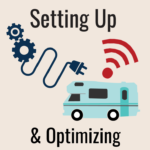

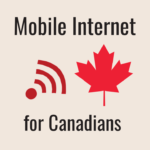
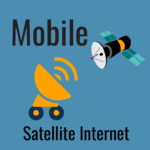
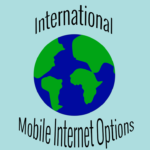
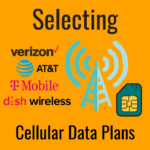
 Mobile Internet Resource Center (dba Two Steps Beyond LLC) is founded by Chris & Cherie of
Mobile Internet Resource Center (dba Two Steps Beyond LLC) is founded by Chris & Cherie of